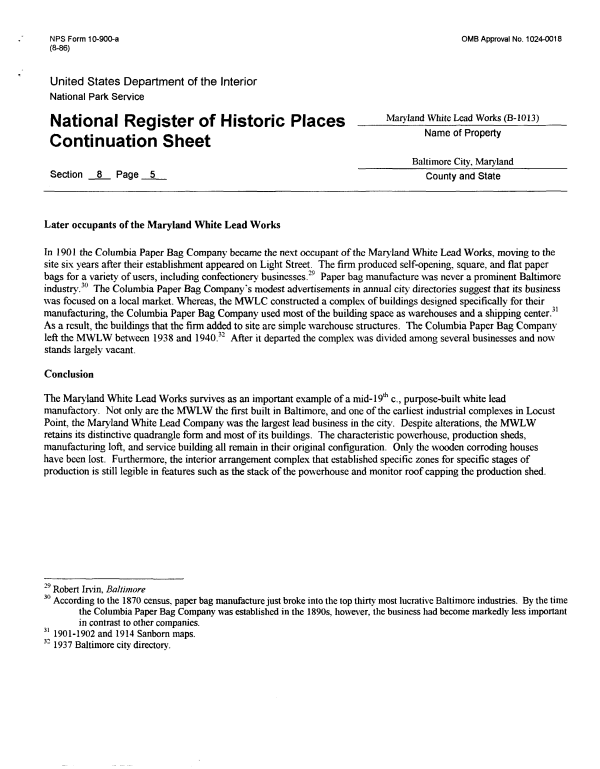 |
||||
|
DEPARTMENT OF HOUSING AND COMMUNITY DEVELOPMENT, MARYLAND HISTORICAL TRUST (Historic Sites Survey) var.d. MSA SE16-2 Image No: se16-2-0013 Enlarge and print image (54K) |
 |
||||
|
DEPARTMENT OF HOUSING AND COMMUNITY DEVELOPMENT, MARYLAND HISTORICAL TRUST (Historic Sites Survey) var.d. MSA SE16-2 Image No: se16-2-0013 Enlarge and print image (54K) |
| NFS Form 1 0-900-a OMB Approval No. 1 024-001 8 (8-86) United States Department of the Interior National Park Service Mai?land ™* Lead Works (B-1013) National Register of Historic Places ^ .. .. -» . , Name of Property Continuation Sheet Baltimore City, Maryland Section 8 Page 5 County and State Later occupants of the Maryland White Lead Works In 1901 the Columbia Paper Bag Company became the next occupant of the Maryland White Lead Works, moving to the site six years after their establishment appeared on Light Street. The firm produced self-opening, square, and flat paper bags for a variety of users, including confectionery businesses.29 Paper bag manufacture was never a prominent Baltimore industry."0 The Columbia Paper Bag Company's modest advertisements in annual city directories suggest that its business was focused on a local market. Whereas, the MWLC constructed a complex of buildings designed specifically for their manufacturing, the Columbia Paper Bag Company used most of the building space as warehouses and a shipping center.31 As a result, the buildings that the firm added to site are simple warehouse structures. The Columbia Paper Bag Company left the MWLW between 1938 and 1940.32 After it departed the complex was divided among several businesses and now stands largely vacant. Conclusion The Maryland White Lead Works survives as an important example of a mid-19th c., purpose-built white lead manufactory. Not only are the MWLW the first built in Baltimore, and one of the earliest industrial complexes in Locust Point, the Maryland White Lead Company was the largest lead business in the city. Despite alterations, the MWLW retains its distinctive quadrangle form and most of its buildings. The characteristic powerhouse, production sheds, manufacturing loft, and service building all remain in their original configuration. Only the wooden corroding houses have been lost. Furthermore, the interior arrangement complex that established specific zones for specific stages of production is still legible in features such as the stack of the powerhouse and monitor roof capping the production shed. 29 Robert Irvin, Baltimore 30 According to the 1870 census, paper bag manufacture just broke into the top thirty most lucrative Baltimore industries. By the time the Columbia Paper Bag Company was established in die 1890s, however, the business had become markedly less important in contrast to other companies. 3' 1901-1902 and 1914 Sanborn maps. 321937 Baltimore city directory. |